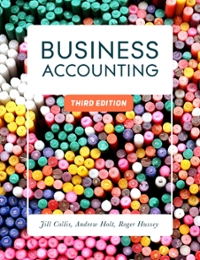Question
CC manufactures three bicycle models, a racing bike, a mountain bike, and a children's bike. The racing model (RM) is made of a titanium-aluminum alloy.
CC manufactures three bicycle models, a racing bike, a mountain bike, and a children's bike. The racing model (RM) is made of a titanium-aluminum alloy. The mountain bike (MB) is made of aluminum. The children's bike (CB) is steel framed. Because of the different materials used, production processes differ significantly among models in terms of machine types and time requirements. Once parts are produced, however, assembly time per unit required for each type of bike is similar. For this reason, CC allocates overhead on the basis of machine hours. Last year, CC produced 1,000 RM, 2,000 MB, and 5,000 CB and had the following revenues and expenses:
CC
Income Statement
RM
MB
CB
Total
Sales revenue
$ 380,000
$ 560,000
$ 475,000
$ 1,415,000
Direct Costs:
Direct materials
150,000
240,000
200,000
590,000
Direct labor
14,400
24,000
54,000
92,400
Variable overhead
Machine setup
?
?
?
26,000
Order processing
?
?
?
64,000
Warehousing costs
?
?
?
93,000
Energy to run machines
?
?
?
42,000
Shipping
?
?
?
36,000
Total Variable costs
943,400
Contribution margin
471,600
Fixed overhead
Plant administration
88,000
Other fixed overhead
140,000
Gross profit
$ 243,000
The Chief Financial Officer (CFO) of CC hired a consultant to recommend cost allocation bases. The consultant recommended the following:
ACTIVITY LEVEL
Activity
Cost Driver
RM
MB
CB
1. Machine setup
Number of production runs
22
34
44
2. Sales order processing
Number of sales orders received
400
600
600
3. Warehousing costs
Number of units held in inventory
200
200
400
4. Energy
Machine Hours
10,000
16,000
24,000
5. Shipping
Number of units shipped
1,000
4,000
10,000
The consultant found no basis for allocating the plant administration and other fixed overhead costs and recommended that these not be applied to products.
Required:
1. Using machine hours to allocate production overhead, complete the income statement for CC. Do not attempt to allocate plant administration or other fixed overhead costs.
2. Complete the income statement using the bases recommended by the consultant.
3. How might activity-based costing result in better decisions by CC's management.
4. After hearing the consultant's recommendations, the CFO decided to adopt activity based costing but expressed concern about not allocating some of the overhead to the products (plant administration and other fixed overhead costs). In the CFO's view, "Products have to bear a fair share of all overhead or we won't be covering all of our costs." How would you respond to this comment?

Step by Step Solution
There are 3 Steps involved in it
Step: 1

Get Instant Access to Expert-Tailored Solutions
See step-by-step solutions with expert insights and AI powered tools for academic success
Step: 2

Step: 3

Ace Your Homework with AI
Get the answers you need in no time with our AI-driven, step-by-step assistance
Get Started


